
Scientific studies show that indoor air quality plays an essential role in raising and maintaining the health, safety and productivity of occupants.
According to the World Green Building Council (WGBC), better indoor quality can improve workers’ productivity up to 11%. The quality of indoor air can be determined as low concentrations of carbon dioxide (CO2) or other pollutants through therecycling of air in the area.
Proper ventilation is not only important to keep occupants healthy and comfortable but it also helps to improve the quality and condition of the building.
As an occupant, it can be difficult to determine if you have the proper amount of ventilation inside your house or office building. If you feel the heat inside your living or work space, this is a sign that you need to upgrade your ventilation system but this is just one indicator.
There are still others that you might have ignored which can also indicate that you may have a poor ventilation system.
High Humidity Level
If your house is not well-ventilated, moisture in the form of condensation may occur especially on flat surfaces or behind furniture or fixtures. You may also notice moisture build-up on your windows and glass-made doors due to trapped and/or uncirculated heat inside the building.
One of the major issues that can be caused by high humidity inside a house or office building is the discomfort it can bring to occupants.
Roof Damage
Poor ventilation can also lead to rotting roofs and wooden fitments. Roof rot or “dry rot” is caused by wood decaying fungi that live in humid or damp areas where they can hide and reproduce at a temperature most suitable for them.
If not treated immediately, roof rots can cause considerable damage.
Indoor Odours
Sometimes air fresheners and scented candles only mask the smell of unpleasant indoor air and the better solution for you is to improve your building’s ventilation system.
Proper ventilation can enhance the air quality of a building as better air circulation which is an important factor in eliminating odours, pollutants and other contaminants.
Comfort and Health
As occupants go in and out of the building throughout the day, the quality of air also changes because they continually bring in pollutants they pick up from the outside environment.
Without proper ventilation, these airborne pollutants will remain inside the building and can trigger common health issues like asthma, allergies, coughs and other respiratory problems.
Likewise, carbon dioxide (CO2) as a byproduct of human metabolism can build up in poorly ventilated building spaces leading to lethargy and tiredness among the occupants.
So poor ventilation does not only affect the physical condition of occupants but can also have a psychological impact manifested in effects such as stress and discomfort.
High Energy Bills
The temperature inside your roof/attic space can exceed 70° C or 170° F during summer. In order to regulate this, you will be required to increase your costs through energy consumption through longer hours of running the air-conditioning at higher outputs and/or improved (but costly) to maintain cooler air inside the building.
With the right choice of renewable energy powered ventilator, you can get fresher air at no extra energy expenditure.
Our Surefire Solutions to Poor Ventilation

SG Eco Industries is one of the leading providers of environmentally friendly ventilators for industrial, commercial and residential applications through our patented Green-vent technologies among others.
These allow us to design and provide ventilation systems that exceed the needs of our clients at a cost effective price and with low running and maintenance costs. We also have our own in-house team of experts who can help you install the system to your complete satisfaction.
Contact us at (+6345) 499-1037 or fill in our contact form and we will be happy to answer your enquiries!
(Article first published on: worldgbc.org |September 24, 2014)
Another recent study shows how a well-designed office can improve employees’ productivity inside the building… World GBC finds that a range of factors – from air quality and lighting, to views of nature and interior layout – can affect the health, satisfaction and job performance of office workers. For natural lighting and ventilation system, check out our site at http://www.eco.ph/
A new report from the World Green Building Council (World GBC) finds “overwhelming evidence” that office design significantly impacts the health, wellbeing and productivity of staff.
Health, Wellbeing and Productivity in Offices: The Next Chapter for Green Building finds that a range of factors – from air quality and lighting, to views of nature and interior layout – can affect the health, satisfaction and job performance of office workers.
The report – sponsored by JLL, Lend Lease and Skanska – also presents a simple toolkit that businesses can use to measure the health, wellbeing and productivity of their buildings and inform financial decision-making.
Understanding the link between workers and their workplace helps to drive the business case for higher quality, healthy and greener buildings, valued by investors, developers and tenants alike.
With salaries and benefits typically responsible for 90 percent of an organization’s expenditure, any higher construction or occupation costs are far outweighed by even small improvements in staff performance.
Jane Henley, CEO of the World Green Building Council, said: “The evidence linking good office design and improved health, wellbeing and productivity of staff is now overwhelming. There is unquestionably a clear business case for investing in, developing and occupying healthier, greener buildings.
“Most businesses are already sitting on a treasure trove of information that can have an immediate impact on their two biggest expenses – people and buildings. Understanding the relationship between the two can help businesses achieve significant competitive advantage.”
Claudia Hamm, Head of Strategic Workplace (EMEA) at JLL, said: “Major corporate clients are now recognizing the business benefits and productivity gains of buildings which bring out the best in their employees and are increasingly making their strategic real estate decisions with these in mind. This report reinforces the view that a building’s impact on its occupants must be included within financial considerations.”
Geoff Dutaillis, Group Head of Sustainability at Lend Lease, said: “Whatever business you are in, you are in the business of people. How a building ‘works for people’ should be the priority question. This report provides further evidence that workplaces with clean air, natural daylight and engaging and adaptable layouts all contribute to making healthier, happier and more motivated individuals who create stronger, more resilient and profitable companies.”
Staffan Haglind, Green Business Officer at Skanska, said: “The equation for our clients is very simple: a small percentage improvement in the health and productivity of your staff far outweighs any additional costs associated with commissioning or occupying a greener, healthier office. Giving employees the best possible conditions to perform and stay healthy is not only wise from a financial perspective, it’s just the right thing to do.”
Health, Wellbeing and Productivity in Offices builds upon the 2013 World GBC report The Business Case for Green Building which featured a chapter on the health and productivity benefits of green buildings.
The report will be launched in London on 24 September as part of World Green Building Week. Global launch events hosted by Green Building Councils will follow in Athens, Greece (24 Sep), Sydney, Australia (25 Sep), Manila, Philippines (25 Sep), Sofia, Bulgaria (26 Sep) and Bogota, Colombia (1-2 Oct). For more information on events, visit our events page.
The report can be downloaded here.
Summary of evidence
Indoor air quality: A comprehensive body of research suggests that better indoor air quality (low concentrations of CO2 and pollutants and high ventilation rates) can lead to productivity improvements of 8-11%.
Thermal comfort: Research demonstrates that thermal comfort has a significant impact on workplace satisfaction and modest degrees of personal control over thermal comfort can return single digit improvements in productivity.
Lighting and views of nature: Several studies have estimated productivity gains as a result of proximity to windows, with experts now thinking that views from windows are probably the more significant factor, particularly where the view offers a connection to nature.
Noise and acoustics: Research suggests that being productive in the modern knowledge-based office is practically impossible when noise provides an unwanted distraction. This can be a major cause of dissatisfaction amongst occupants.
Interior layout: The way the interior of an office is configured (including workstation density and configuration of work space, breakout space and social space) has been found to have an impact on concentration, collaboration, confidentiality and creativity.
Active design and exercise: Health can be improved through exercise, and so active design within a building, and access to services and amenities such as gyms, bicycle storage and green space can help to encourage healthier lifestyles of building occupants.
Toolkit to measure health, wellbeing and productivity
Financial metrics: Absenteeism, staff turnover, revenue breakdown (by department or per building), medical costs and complaints, and physical complaints.
Perceptual metrics: Studies which test a range of self-reported attitudes into health, wellbeing and productivity in the workplace can contain a wealth of information for improving office performance.
Physical metrics: Direct measures of the physical office environment, such as temperature, are key to measuring the effect on the health, wellbeing and productivity of workers. Exciting developments in this area such as portable and wearable technology are likely to substantially expand our understanding.
Steering Committee
Miles Keeping (Chair), Deloitte Real Estate
Dr Fiona Adshead, Independent Advisor
Staffan Haglind, Skanska
Claudia Hamm, JLL
Robert Lam, Wong & Ouyang
Roger Limoges, US Green Building Council
Prof Vivian Loftness, Carnegie Mellon University
Mark Nicholls, Retired Bank of America Real Estate Executive
Hector Sandoval, Carrier Enterprise
Ché Wall, Flux Consultants
Duncan Young, Lend Lease
Corporate sponsors of the report:
JLL, Lend Lease and Skanska
Project partners:
Colombia Green Building Council, Hong Kong Green Building Council, US Green Building Council and UK Green Building Council
Media Contact:
Karen Jamal
Communications
World Green Building Council
karen@kjcommunications.com
+61 2 6288 3419

Roof works always involve risk and potential injuries especially if you are not using the right equipment for roof access.
According to the Occupational Safety and Health Administration (OSHA), more than 100,000 workers in the United States are injured annually due to falls on construction sites.
In order to avoid becoming a victim, installing a safe access system to rooftops is one of the best solutions.
SG Eco’s Roof Access Hatchways provide the safest and most convenient entry to your roof. These hatchways are ideal for domestic and commercial buildings.
Falling from Ladders
This is one of the leading causes of fatalities whether on occupational or non-occupational activities. It can happen due to various reasons: over-balancing, unstable footing or soft ground, defective or loose ladder components etc.
 Fall-off injuries related to ladder can be substantially reduced with the use of Access Hatchways. This product allows workers or residents to safely access their roofs with its Gapseal Foam, sealing and supporting its lid to prevent any movement especially during strong winds.
Fall-off injuries related to ladder can be substantially reduced with the use of Access Hatchways. This product allows workers or residents to safely access their roofs with its Gapseal Foam, sealing and supporting its lid to prevent any movement especially during strong winds.
Getting trapped or crushed between MEWPs
Mobile Elevating Work Platforms (MEWPs) are machinery or equipment that is in different jobs that require working at heights such as tree cutting/trimming and roof work.
The use of MEWPs can reduce the time and effort of workers but inadequate knowledge on how to operate these machines can also lead to serious injuries such as entrapment and collision of the equipment with adjacent structures.
 Access Hatchways no longer require additional machinery or equipment in order to gain access to your roof. It is manufactured from 0.75mm sheet metal for durability. Its design also offers ease of use to customers and is suitable for most roof type.
Access Hatchways no longer require additional machinery or equipment in order to gain access to your roof. It is manufactured from 0.75mm sheet metal for durability. Its design also offers ease of use to customers and is suitable for most roof type.
Electrical Injury
Most of us do not think about the possibility of electrocution when we access the roof with a ladder.
If a metal ladder comes into contact with damaged electrical cables, you can be exposed to electrical injuries because of the easier transmission of the current into your body.
 As opposed to ladders, Hatchways are placed permanently on your rooftop to avoid interfering with electrical cabling every time you do roof work.The SG Eco team can help you find a safer location for your Access Hatchways and install it to avoid close contact with cabling on your rooftop.
As opposed to ladders, Hatchways are placed permanently on your rooftop to avoid interfering with electrical cabling every time you do roof work.The SG Eco team can help you find a safer location for your Access Hatchways and install it to avoid close contact with cabling on your rooftop.
Risk of Falling Objects
Accidents due to falling objects which can lead to injury or death to workers and even by-passers or onlookers can be prevented if you have a safer access system to your roof.
 Aside from the padlockable latch from the inside which provides additional security against unwanted intrusion, Dome Lid Access Hatchways also allows natural light to enter the building thereby improving the ambient lighting within the building.
Aside from the padlockable latch from the inside which provides additional security against unwanted intrusion, Dome Lid Access Hatchways also allows natural light to enter the building thereby improving the ambient lighting within the building.
We will be Glad to Hear from You!
Our Access Hatchways come with three different lid types - Steel, Insulated and Dome. To learn more about these products and others in our range, feel free to contact us at +63 (45) 499 1037 or fill in our contact form.

AIR POLLUTION. Midday traffic moves slowly through air pollution which exceeds the level of 400 on the air quality index, rating a hazardous warning, in Beijing, China, 26 March 2014. Adrian Bradshaw/EPA
(Article first published online: September 09 | rappler.com)
Reversing the effect of climate change cannot be done overnight but simple household efforts can make a huge difference. Reducing electric usage will not only let you save money but will also help you lessen Greenhouse gas emission. Find out how our products can help you: http://www.eco.ph/
(UPDATED) WMO chief: 'We know without any doubt that our climate is changing and our weather is becoming more extreme due to human activities such as the burning of fossil fuels'.
GENEVA, Switzerland (UPDATED) – Surging carbon dioxide levels boosted greenhouse gases in the atmosphere to a new high in 2013, amid worrying signs that absorption by land and sea is waning, the UN warned Tuesday, September 9.
"An alarm bell is ringing," Michel Jarraud, head of the World Meteorological Organization (WMO), told reporters in Geneva.
In its annual report on Earth-warming greenhouse gases in the atmosphere, the UN agency said concentrations of carbon dioxide (CO2), methane and nitrous oxide all broke records in 2013.
"We know without any doubt that our climate is changing and our weather is becoming more extreme due to human activities such as the burning of fossil fuels," Jarraud said.
"We must reverse this trend by cutting emissions of CO2 and other greenhouse gases across the board," he said in a statement, and warned: "we are running out of time."
Especially worrying, Jarraud said, was the sharp rise in CO2, by far the main culprit in global warming, to 396 parts per million in the atmosphere last year.
That was 142% of levels prior to the year 1750, and marked a hike of 2.9 parts per million between 2012 and 2013 – the largest annual increase in 30 years.
It was not clear why concentrations rose so sharply, but Jarraud suggested it could be due to a shift in the ability of oceans and the biosphere to absorb emissions.
'A worrying signal'
Oceans swallow about a quarter of greenhouse gas emissions, while the biosphere sucks up another quarter, so any change "could potentially have big consequences," he warned.
"Clearly now we have a signal, ... a worrying signal," said Jarraud.
University of Reading meteorology professor William Collins said the WMO's suggestion that the biosphere may be removing less CO2 as the climate warms was credible, and implied a "future amplification of climate change".
"We can't expect to benefit from this natural removal for ever," he warned.
Tuesday's report came ahead of a September 23 summit called by UN Secretary General Ban Ki-moon to try and build momentum ahead of the 2015 deadline for a historic climate deal to be signed in Paris, to take effect from 2020.
The UN is seeking to limit global warming to two degrees Celsius (3.6 degrees Fahrenheit) over pre-Industrial Revolution levels, but scientists say that on current emission trends, temperatures could be double that by century's end.
"We have the knowledge and we have the tools for action to try to keep temperature increases within two degrees Celsius to give our planet a chance and to give our children and grandchildren a future," Jarraud said, insisting that "pleading ignorance can no longer be an excuse for not acting".
Professor Dave Reay, chair in carbon management at the University of Edinburgh, reacted to the report with dismay.
"This is the litmus test when it comes to our efforts to reduce emissions and on this evidence we are failing," he said.
The findings are especially worrying since CO2 remains in the atmosphere for hundreds of years and in the oceans for even longer.
While the ocean's absorption of CO2 helps limit global warming, "the bad news is that it contributes to the acidification of the ocean," Jarraud said.
Increased acidity not only alters the ocean's ecosystem, but can also reduce its ability to absorb more CO2, he said.
Every day the world's oceans absorb some four kg (8.8 pounds) of CO2 per person, the WMO said, adding that ocean acidification levels were "unprecedented at least over the last 300 million years".
And things will only get worse, said Jarraud.
"Past, present and future CO2 emissions will have a cumulative impact on both global warming and ocean acidification," he said, adding that "the laws of physics are non-negotiable". – Rappler.com
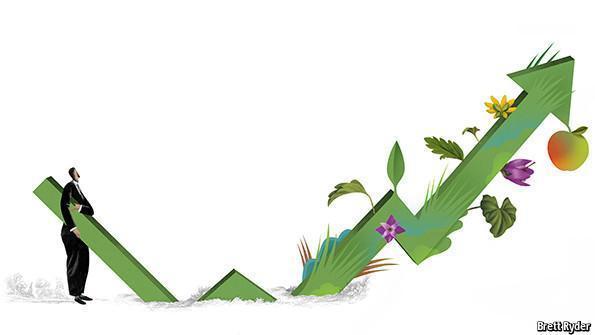
(Article first published online: August 30 I economist.com)
A few pioneering businesses are developing “sustainability policies” worthy of the name. Sustainability plans focus on saving energy, cutting waste and streamlining logistics.
Choose the right eco-friendly products that can boost your sustainability efforts without reducing your profit. Visit our site at http://www.eco.ph/
BILL MCKIBBEN, an American environmentalist, once dismissed sustainability as “a buzzless buzzword”. That seems about right. A survey of 2,000 companies by the MIT Sloan Management Review and the Boston Consulting Group found that two-thirds of businesspeople thought social and environmental matters were “significant” or “very significant” but that only 10% thought they themselves were doing enough about it.
That sense of disappointment should be no surprise. Sustainability can refer to anything from building wind farms to combating social inequality. The idea crops up everywhere from Starbucks to the deliberations of the United Nations (whose governments are in the middle of working out a set of so-called Sustainable Development Goals for 2015-30). An ill-defined, controversial notion is no basis for coherent policy.
Many corporate “sustainability plans” are therefore modest. They focus on saving energy, cutting waste and streamlining logistics. Nothing wrong with that: these things reduce operating costs while benefiting the environment. They help explain why sustainability efforts tend to increase profits, not reduce them. A study by Robert Eccles and George Serafeim of the Harvard Business School (HBS) found that, between 1992 and 2010, companies which adopted what they call high-sustainability policies were more profitable and improved their stockmarket valuation more than those which did not (though this may just have been because high-sustainability firms happened to be better managed).
However, there are drawbacks to such plans. For one thing, they are misnamed: these are efficiency policies, not sustainability ones. Companies ought to want to save energy or cut waste anyway, regardless of the impact on the environment. And it turns out that many of the schemes do not in fact do that much for the environment or social equity. The majority of greenhouse-gas emissions associated with consumer goods, for example, are produced either in the supply chain or by shoppers. So there is only limited scope for such products’ makers to lessen their environmental footprints through green measures of their own.
As a result, most corporate sustainability plans rarely amount to more than cost-saving measures and compliance with government regulations, plus a few projects with a public-relations punch (say, reforesting parts of a cleared jungle). They fall well short of putting sustainability at the heart of what firms do.
For some companies, though, that is changing. Take SABMiller, the world’s second-largest brewer. The firm has been a pioneer in the field. But until recently its sustainability efforts consisted of a laundry list of targets (there used to be ten) aimed at reducing carbon emissions or water usage in its brewing operations. This summer it unveiled new, broader targets—only five this time—which apply to suppliers, sellers and customers, as well as to SABMiller itself. It is promising to teach basic business skills to 500,000 small enterprises, mostly shops which sell its beer. It is helping farmers use water more efficiently: in Rajasthan, in northern India, it is working with wheat farmers who have been depleting their aquifer to reduce water use by a quarter, to ensure it still has water to brew beer. And it is sponsoring anti-drunkenness and road-safety campaigns aimed at its own customers.
Jane Nelson, director of the Corporate Social Responsibility Initiative at the Harvard Kennedy School, says SABMiller’s efforts are characteristic of a new wave of sustainability plans. These set targets not only for the company but for the people it works with and sells to. The targets are not only about the environment but society at large. (In a spectacular example, Unilever, an Anglo-Dutch consumer-goods giant, says it aims to “help a billion people take steps to improve their health and well-being”.) They are supervised by the board, not left to specialists. Domtar, an American fibre company, created a sustainability committee but the vice-president for sustainability does not chair it; the chair rotates among other managers so as to involve the firm as a whole. In short, she argues, for some companies sustainability has become a core part of their strategy, not just a green way to cut costs.
Little green men
But why should firms make sustainability central to what they do? Environmentalists might reply that virtue is its own reward. But companies need more concrete returns—higher profits, say, or increased sales, or higher stockmarket valuations.
The first wave of sustainability policies provided those. The new wave may not: sustainability targets could raise costs, not cut them, making environmentally friendly consumer goods more expensive than the eco-hostile variety. Efforts to combat social inequality could boost wages. Training can be costly.
Paul Polman, the boss of Unilever, argues that good sustainability policies still improve the fundamentals of businesses in the long run. They change customers’ behaviour in beneficial ways—by, say, increasing demand for green products that the firm makes. They also please investors concerned about environmental threats. The trouble is that consumer behaviour is often slow to change and that, if green products are too expensive, the firm risks losing market share. Environmental investors are still a minority among shareholders, most of whom continue to be more concerned about quarterly earnings.
The first wave of sustainability rewarded itself. The new wave will not do that. It is more akin to investing now to have a licence to operate in future, when consumers, lobbyists and regulators will be ever more demanding about the way firms behave. That does not mean the new wave will not reward its adopters. But it will boost their long-term competitive position, rather than their short-term profits. Unlike the rewards of the superficial first wave, those of deeper sustainability could take years to sink in.

Since moving into the age of the ‘green revolution’, property owners have been looking for ways to improve the safety and comfort of their homes and buildings utilizing environmentally friendly products.
You may have heard of skylights, but do you know exactly how good they can be for you? Aside from the more obvious benefits of cost effectiveness and enhanced aesthetics for commercial and residential buildings, skylights can also improve your health and boost productivity through the natural light they provide.
Why Skylights?
This daylighting device transfers natural light from outside the building and delivers it to the living or work space contained within. Sounds simple enough but the design, manufacture and installation of the units are all critical stages toward their effective operation. SG Eco has been operating in this line of business for nearly 20 years and has an impressive track record to show for it.
Skylights are also suitable for domestic applications such as bathrooms, kitchens and hallways.
 Contribution to the ‘Green Revolution’
Contribution to the ‘Green Revolution’
It takes a collaborative effort to help protect Mother Earth.
Skylights are beneficial to large corporations and commercial operators as well as individual households not just because it reduces their electricity consumption but because that in turn, reduces their Carbon Footprint or the amount of greenhouse gases produced to generate that electricity.

 Convenient and Cost Effective
Convenient and Cost Effective
Cost savings are important to everyone.
One of the great advantages of skylights are their electricity-free operation. One of SG Eco’s case studies illustrates how a manufacturing plant could save up to 39,000 kwh per year after it installed 56 evenly distributed 535mm Sky tunnels on to its building.
To see full case study, click here: http://www.eco.ph/pdf/Case-Studies/Commercial-CS.pdf
And because the skylights are not reliant on power from the grid or local supply network, they are not affected by power interruptions, should they occur.
 Promotes Safety and Comfort
Promotes Safety and Comfort
Safety and comfort are two of the most important considerations when building a house.
It’s a big challenge to design or adapt a property that is comfortable for all its occupants. Well, here is another way that SG Eco Skylights can help you achieve that? Installing Sky Tunnels does not create additional heat load within your house because the components of its tubing do not retain or transmit heat. The devices use a triple glazed system that makes it resistant to heat and humidity.

 Aesthetic Appeal
Aesthetic Appeal
Unlike traditional skylights, our Sky Tunnels are UV stabilized, made of highly durable materials and have an acrylic dome that allows more light to enter the tube. Its slick and smart design improves the aesthetics of your homes’ exterior while providing an optimal lighting system for its interior.
Share the Good News!
SG Eco has been a global leader in providing tubular skylights for over 20 years and their Sky Tunnel Tubular Skylights come with a 7-year manufacturer’s warranty. For more enquiries about our products, contact us at +63 (45) 499 1037 or fill in our contact form.

( Related News)
A study conducted by researchers at the Northwest Medicine and the University of Illinois at Urbana-Champaign shows how natural light can boost workers' health in the office. SG Eco's Skylights are designed to convey light into a house or building with greater efficiency and ease through free and renewable energy from the sun. Check out our site at http://www.eco.ph/ for more eco-friendly products.
CHICAGO — Office workers with more light exposure at the office had longer sleep duration, better sleep quality, more physical activity and better quality of life compared to office workers with less light exposure in the workplace, reports a new study from Northwestern Medicine and the University of Illinois at Urbana-Champaign.
The study highlights the importance of exposure to natural light to employee health and the priority architectural designs of office environments should place on natural daylight exposure for workers, the study authors said.
Employees with windows in the workplace received 173 percent more white light exposure during work hours and slept an average of 46 minutes more per night than employees who did not have the natural light exposure in the workplace. There also was a trend for workers in offices with windows to have more physical activity than those without windows.
Workers without windows reported poorer scores than their counterparts on quality of life measures related to physical problems and vitality, as well as poorer outcomes on measures of overall sleep quality and sleep disturbances.
The study was reported in the Journal of Clinical Sleep Medicine in June.
“There is increasing evidence that exposure to light, during the day, particularly in the morning, is beneficial to your health via its effects on mood, alertness and metabolism,” said senior study author Phyllis Zee, M.D., a Northwestern Medicine neurologist and sleep specialist. “Workers are a group at risk because they are typically indoors often without access to natural or even artificial bright light for the entire day. The study results confirm that light during the natural daylight hours has powerful effects on health.”
Zee is the Benjamin and Virginia T. Boshes Professor of Neurology at Northwestern University Feinberg School of Medicine and director of the Sleep Disorders Center at Northwestern Memorial Hospital.
“Architects need to be aware of the importance of natural light not only in terms of their potential energy savings but also in terms of affecting occupants’ health,” said co-lead author Mohamed Boubekri, an associate professor of architecture at the University of Illinois at Urbana-Champaign.
A simple design solution to augment daylight penetration in office buildings would be to make sure the workstations are within 20 to 25 feet of the peripheral walls containing the windows, noted Boubekri. “Daylight from side windows almost vanishes after 20 to 25 feet from the windows,” he said.
The study group included 49 day-shift office workers; 27 in windowless workplaces and 22 in workplaces with windows. Health-related quality of life and sleep quality were measured with a self-reported form and sleep quality was evaluated with the Pittsburgh Sleep Quality Index (PSQI). Light exposure, activity and sleep were measured by actigraphy in a representative subset of 21 participants; 10 in windowless workplaces and 11 in workplaces with windows.
Actigraphy is a single device worn on the wrist that gives measures of light exposure as well as activity and sleep. This is an ambulatory physiological data logger that records motion and light illuminance. The motion was used to determine activity levels during waking time and to calculate sleep time. The light luminance was used for measures of light exposure during the workday period.
“Light is the most important synchronizing agent for the brain and body,” said Ivy Cheung, co-lead author and Ph.D. candidate in neuroscience in Zee’s lab at Northwestern. “Proper synchronization of your internal biological rhythms with the earth’s daily rotation has been shown to be essential for health.”
Also, people who get more light during the day may sleep better at night, which can also help improve health, Zee noted.
Other authors include Kathryn Reid from Northwestern and Chia Hui-Wang from the University of Illinois.
###
The research was supported by grants 5T32 HL790915 from the National Heart, Lung and Blood Institute and P01 AG11412 from National Institute on Aging, of the National Institutes of Health.
(Image source: google.com)
Source: http://www.stonehearthnewsletters.com/natural-light-offices-boosts-health/sleep/
Since the ‘green revolution’ started, many residential and commercial buildings have begun utilizing eco-friendly products that can decrease the emission of heat-trapping gases via alternative energy usage. SG Eco ventilators are among the leading eco-friendly products that promote proper ventilation as well as reduce harmful emissions.
More than just environmental, here are some of the additional benefits that SG Eco’s commercial vents can offer.
Improved Productivity from within the Building
If you think that higher compensation and competitive benefits are enough to increase the productivity rate of your employees, wait until you know how proper ventilation can change this ‘rule of the book’.
A report titled, Indoor Climate and Productivity” written by Olli Seppanen, a Professor at the Helsinki University of Technology in Finland, shows an increasing evidence that indoor environmental conditions can substantially influence your employee’s health and performance.
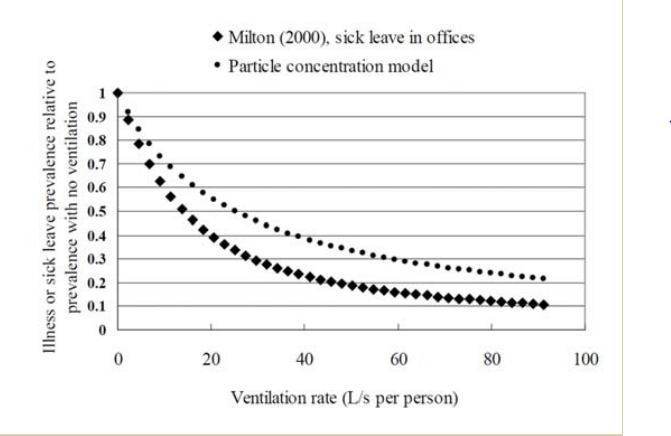
Conclusion: The figure only shows that the increase in ventilation of the internal area of the building decreases the sick leave or absences of employees due to health issues.
The graph also shows that there is a real need for companies to build and create a more conducive working environment to improve the productivity of its employees.
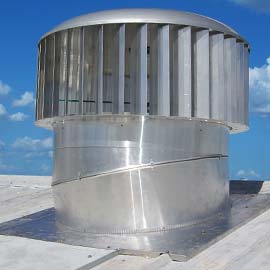
If you worry about the initial energy and maintenance costs of upgrading your ventilation system, Green-vent Wind driven ventilator uses no energy and also requires no maintenance, so the calculation of the cost benefit only needs to include the initial cost of the installation.
Health Wise Internal Environment
A good ventilation system also removes airborne pollutants such as smoke, dust, poisonous gases & fumes from machinery or vehicles that can also help improve the health of the occupants inside the building.
Increased Energy Efficiency of the Building
Excessive heat load on air conditioning ductwork caused by hot air trapped under the roof can cause air conditioners to work longer and harder thus leading to extra energy costs. Green-vent Solar reduces the ceiling temperature without the use of mains electricity.
Noiseless Operation
The Green-vent Solar utilizes a high performance 38V motor that generates very little noise. Coupled with the fact that it is installed on the roof, in most installations you will never hear it operating.

For more enquiries about our products, contact us at +63 (45) 499 1037 or fill in our contact form.
Ventilators improve the indoor air quality and energy efficiency of any building.
The functionality of ventilation systems vary depending on the kind of ventilators used and the area that it covers. SG Eco provides a wide range of ventilators that are suitable for residential, commercial and industrial applications.
Commercial Ventilators
Green-vent Wind Driven Ventilator
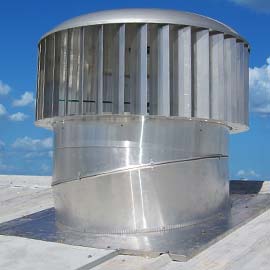 This ventilator is made up of lightweight aluminum that allows continuous airflow at a moderate-low speed. It uses vertical vane technology that is 3 times better than the exhaust capacity of a round shaped ventilator.
This ventilator is made up of lightweight aluminum that allows continuous airflow at a moderate-low speed. It uses vertical vane technology that is 3 times better than the exhaust capacity of a round shaped ventilator.
 Why Do You Need Them?
Why Do You Need Them?
Green-vent Wind Driven Ventilators eliminate air borne pollutants such as smoke, dust and poisonous gases to provide cleaner and fresher air for everyone. Aside from the health and environmental benefits it provides, Wind Driven ventilators also reduce the risk of structural deterioration due to accumulated heat, humidity and air pollution.
Residential Ventilators
Under Eave Vents
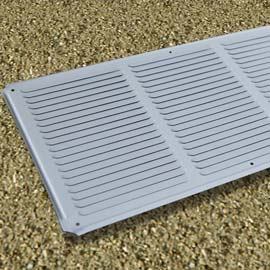 Under eave vents are used as inlet vents for residential ventilators. These inlet vents replace the hot and stale air inside the house with its specially designed large openings between the vanes for a constant airflow through your attic or roof space.
Under eave vents are used as inlet vents for residential ventilators. These inlet vents replace the hot and stale air inside the house with its specially designed large openings between the vanes for a constant airflow through your attic or roof space.
 Why Do You Need Them?
Why Do You Need Them?
Under Eave vents improve the efficiency of any roof ventilation system but also prevent insects from entering your attic or roof space with its built-in insect mesh. Buying this product will not only let you keep your house safe from extreme weather conditions but also protects your family from disease-carrying insects.
Whirlwind Roof Ventilator
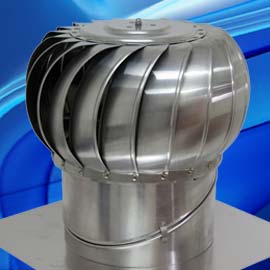 This ventilator works in two ways. It exhausts hot stale air during summer and moisture-laden air during winter. The lightweight marine grade aluminum structure and low torque double bearing system allow the Whirlwind to operate more efficiently, even at low wind speeds.
This ventilator works in two ways. It exhausts hot stale air during summer and moisture-laden air during winter. The lightweight marine grade aluminum structure and low torque double bearing system allow the Whirlwind to operate more efficiently, even at low wind speeds.
 Why Do You Need Them?
Why Do You Need Them?
If you are living in a low-wind area, this product is right for you. Its low torque bearings and large vane openings provide a better air flow even at lower wind speed.
Solar Powered Ventilators
Solar Attic Extraction Fan
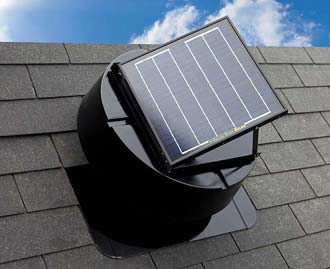 The Green-Vent Solar Attic Extraction Fan is an attic ventilation system that can be installed into commercial or residential roofs to remove the trapped heat between the ceiling and the roof. It uses photovoltaic solar panels that automatically convert the natural solar energy from the sun into usable electrical energy.
The Green-Vent Solar Attic Extraction Fan is an attic ventilation system that can be installed into commercial or residential roofs to remove the trapped heat between the ceiling and the roof. It uses photovoltaic solar panels that automatically convert the natural solar energy from the sun into usable electrical energy.
 Why Do You Need Them?
Why Do You Need Them?
Solar Attic Extraction Fan prolongs the life of your roofing system as it quietly vents the hot air between your building’s ceiling and roof utilizing its modern design and solar panels.
To find more about SG Eco’s ventilators, click this link: http://www.eco.ph/green-vent-ventilation-products. You may also contact us at +63 (45) 499 1037 or fill in our contact form.
SG Eco Industries is a pioneering manufacturer and distributor of tubular Skylights, Ventilation Systems, their components and custom OEM manufacturing for the green energy industry. With more than 2 decades of experience, we are specialists in providing customized solutions for client’s construction, manufacturing and OEM outsourcing needs.
The SG Eco blog aims to gather all relevant news and articles on the green construction efforts throughout the world and the green energy industry in general. In the long run, the SG Eco blog will a central source for news and topic on the green energy industry in general.
SG Eco Industries utilizes Australian Technology in both its Sky Tunnel natural lighting and Green Vent ventilation systems. All of our products are manufactured here in the Philippines following strict ISO certification guidelines.
SG Eco Industries is commited to operating in an environmentally friendly manner. This is through conformance to our environmental management system. SG Eco Industries shall exceed all applicable regulatory, legal and other requirements. We are commited to continual environmental improvement as well as minimizing waste products, pollution and anything else that has an adverse impact on the environment. SG Eco Industries is a leader in manufacturing industry. We shall exceed our customers’ expectations through conformance to our quality management system. We are committed to continual improvement in all ares of our business.
For more information about SG Eco Industries and their products and services, please visit our website at www.eco.ph







